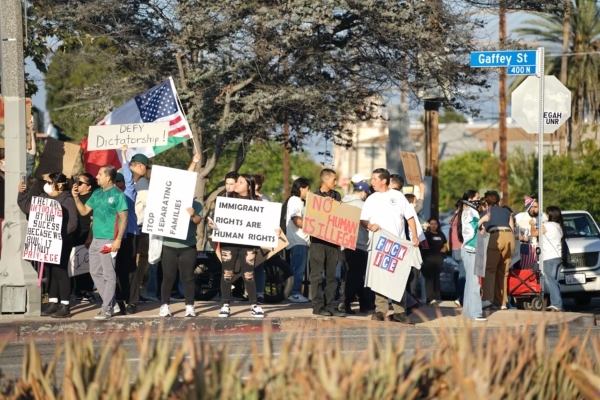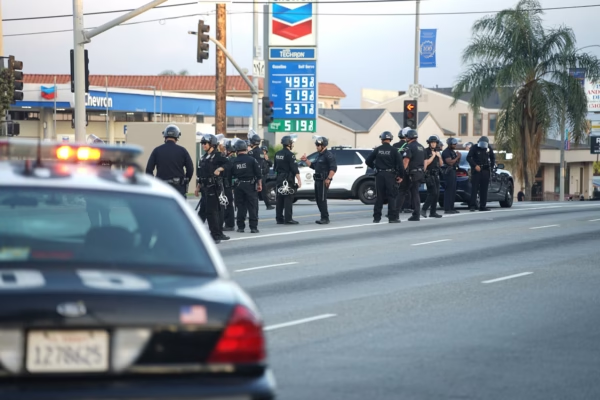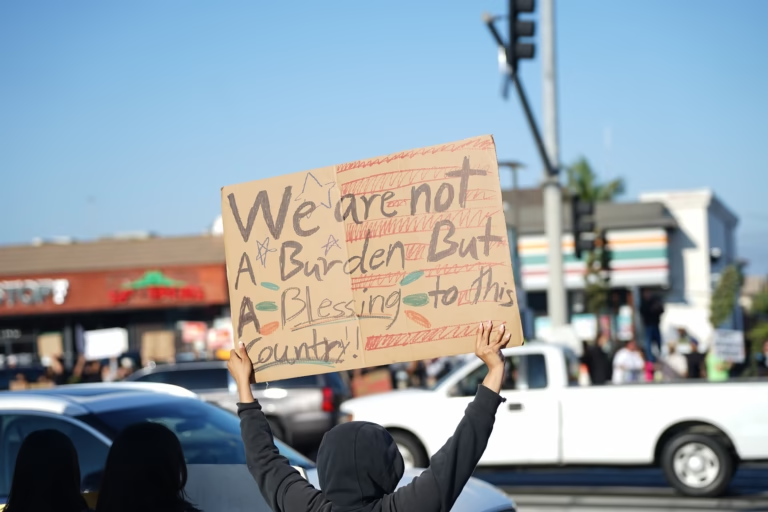By Rosie Knight
It was, like so many contemporary protests are, first shared online: ICE OUT OF SAN PEDRO, the flyer read, 1st and Gaffey at 5 PM. San Pedro is a town with a vibrant tradition of protest in its history and culture, and as expected, the city’s residents passionately turned out. What may have surprised some drivers, though, was just how young the cohort was. Depending on who you listen to, the youth of today are a listless lot with no interest in politics or their community. Anyone who actually knows and listens to young people knows that couldn’t be further from the truth, and San Pedro’s next generation showed out in peaceful and playful force.

For the first hour, the protesters diligently followed traffic laws and stoplights as they walked around the intersection at 1st & Gaffey in San Pedro, convening at the corners where supporters offered free snacks and water to those who had turned out in the late afternoon sunshine. Signs that read “ICE Out of Los Angeles” and “Immigrants Don’t Shoot Up Schools” bobbed above the heads of local teenagers and families with strollers and babies in hand.
It was very much the definition of the peaceful protest that politicians and community members have been calling for, so this reporter must ask the following question: Why as the protesters began walking, slowly and on the sidewalks, to San Pedro Sister Cities Park did 15+ LAPD Squad cars arrive and shutdown the entrance to the Freeway and the lanes of Gaffey down to Sepulveda? What was the need for the white vans filled with cops wearing riot gear? And the dedicated police chopper that circled the protest into the night?

The influx of Immigration and Customs Enforcement raids and the incendiary arrival of the National Guard have sparked nationwide protests, which, yes, began in Los Angeles. However, those protests have, for the most part, been confined to a few blocks of our immense city. And it seems a vast overreaction to police a small local protest with around 100 attendees as if there is a dedicated threat to our community in teenagers and grandma’s holding handmade signs while their neighbors honk their horns at them in response. As usual, the LAPD will surely claim that their presence was necessary to protect the Port of Los Angeles, or in this case, because of proximity to the highway, after the Los Angeles 101 was briefly closed by protesters recently.
San Pedro, like so many areas in Los Angeles, needs investment in our community members and its most vulnerable inhabitants. Longshoremen are being impacted by Trump’s tariffs, families cannot pay their rent, and people are being kidnapped by ICE. Yet instead of the tens of thousands of dollars that this show of force cost being invested into our community, it once again goes instead to policing it.
Ultimately after five hours of peaceful protests surrounded by a heavy police presence and circled by a police helicopter – which local residents who weren’t protesting could hear late into the night – there was according to the Harbor Division Commander Brent McGuyre a reported fight amongst protestors at around 10pm at night. But even with that taken into account according to McGuyre’s own social media posts there was ultimately only one arrest, three citations for reckless driving, as well as two for curfew violations all of which took place hours after the protest had begun.
As one of the young protestors was chanting while the police moved them from Sister Cities Park down Gaffey a copter circling above them “This is what your tax dollars are being spent on.”
Below is a reprint of LAPD Harbor Division’s Commander Brent McGuyer’s update on the June 12 rally after it dispersed.
Quick update on the protest in San Pedro: At around 5 pm, approximately 150 people gathered at 1st/Gaffey to protest “ICE Out of San Pedro.” The group was boisterous but lawfully protesting.
After about an hour and a half, the group began to march northbound on Gaffey towards the 110/47 Freeway entrance. LAPD and CHP officers blocked access to the freeway, but allowed the group to continue to protest.
After another hour, the group marched back southbound on Gaffey and marched between 1st and 4th Street, where they continued to protest relatively peacefully for several more hours
However, as night fell, the tenor of the crowd began to change. Officers observed members openly drinking alcohol, pedestrians blocking the streets, lighting fireworks, and doing car burnouts in the intersections. A little after 10 pm, after five hours of protests, a large fight of approximately 30 people broke out in the group, with several being overpowered and knocked to the ground. Officers intervened, and an unlawful assembly was declared. Officers provided multiple warnings to the crowd as some members threw hard objects at the officers and lit more large fireworks. After an hour and a half, the final vestiges of the 150-person group cleared the area.














